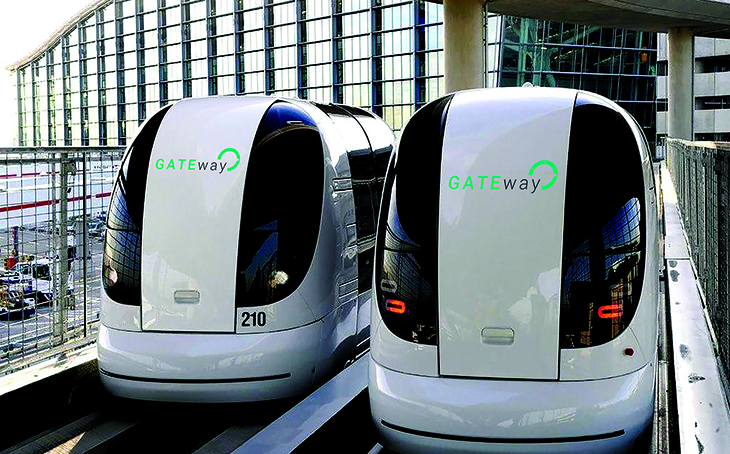Driverless Cars Brave Mean City Streets

Image credits: Courtesy of GATEway project
(Inside Science) -- Cars without drivers face two different worlds: well-spaced highway or suburban roads, and narrow city streets.
A research project in the United Kingdom is tackling the challenges of the city. The Gateway Project, an $11.6 million partnership between the British government and industry, plans to deploy autonomous vehicles in the congested, narrow streets of London. The project will test its first vehicles in Greenwich, along the banks of the Thames, in the spring.
Rather than build their own vehicles, Gateway will use small, six-person passenger pods borrowed from Heathrow airport, said Nick Reed, director of the project.
The pods look like something in a 1950s science fiction movie, although the Royal College of Art has been brought in to give them a makeover. Unlike the Heathrow pods, which now run on rails from a parking lot to a terminal, the new pods will be free-range.
Gateway is part of a strong push toward vehicles commanded by computers and sensors instead of humans. Businesses have adopted two competing approaches to reach this goal.
In the automobile industry, most companies are adding automated controls to existing models. Features like automatic braking and cruise control that senses the distance to the car in front are already available, and every year more are added. Parking is now fully automated for many new autos.
The majority of automobiles may slowly evolve to become driverless.
Other companies, such as Google, are starting from scratch, creating all the technology needed to launch a fully autonomous vehicle. The company's cars already have put in more than a million miles. U.S. driving regulations typically assume a human driver, but earlier this month the National Highway Traffic Safety Administration informed Google that "driver" can be interpreted to refer to the self-driving system, according to a Reuters report.
Another tech giant, Apple, is rumored to be working on an autonomous car, and the industry was shaken by recent news that Uber, the car-ride company, has reportedly hired dozens of robotic experts from Carnegie Mellon University in Pittsburgh and is starting a cooperative arrangement with the school. General Motors and Lyft, another car-ride company, announced an agreement to develop a self-driving car. Neither Apple nor Uber will say what they are doing, but hiring patterns and industry gossip suggest both companies are aiming for a driverless car. So, apparently, is Tesla, which detailed new autopilot features for its Model S and Model X electric cars in a blog earlier this month.
All of these companies' efforts fall into one of two kinds of technologies, said Bryant Walker Smith, an engineer and lawyer at the University of South Carolina: cars that do something everywhere or cars that do everything somewhere.
Gateway's specially designed vehicle is part of the latter category: it will do all standard driving functions in a limited regime. Think of it as something like a driverless Uber, Reed said.
The service would use a smartphone app to call a car and enter a destination. The pods can take up to six people plus baggage and shopping bags. They can even fit a wheelchair, Reed said. Using GPS, the pod would find the optimal route to the destination and go.
The tests this spring will run on a 2.2-mile route in a fairly open space in Greenwich, with stops at both an Intercontinental Hotel and a subway station. Top speed will be 13 miles an hour with speed adjusted for congestion.
Under British law, there must be a "steward" on board to monitor the vehicle. It will have an emergency stop button, Reed said.
If the tests prove successful, they may be able to legally do without the steward's monitoring and move to more congested areas. Besides testing the technology, another goal is to see what people think of the system, how well they accept it, and what they use it for.
Driverless vehicles for cities require different design approaches than vehicles for highways like America's Interstate system.
"Think of highway driving as high speed, low complexity," Reed said. "City driving is low speed, high complexity. They are different challenges."
Engineers still have a long way to go to overcome all the hurdles, and some people in the industry argue the public underestimates the limits of driverless cars. People think an autonomous vehicle means the driver can sit up front reading a newspaper, said Rob Gray, an engineer at Arizona State University. "That is not going to happen," he said, because such inattention is dangerous, even in mostly automated cars. Someone will have to be up front paying attention.
"The current state of technology," Smith said, "is that we don't have vehicles that can do all of the driving all of the time." Vehicles like those at Gateway will be limited to specific conditions, community, and geography. Those vehicles require slow speed, simplified environment, and some form of supervision.
Add-ons to traditional vehicles keep getting better and do more driving, Smith said, sort of a "mushy middle" of technology, but at some point, humans still have to re-engage. People tend to trust the automation too much and are too easily distracted.
Fully automated cars may not be as versatile as today's cars, driving you to work one day, to the beach the next day, and for a 300-mile trip the next.
"The issue is location, location, location," he said.
And no one is talking about what happens when it snows.

